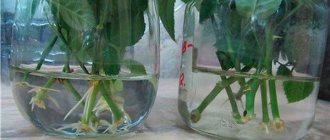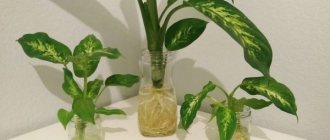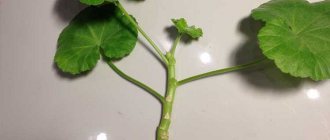Conditions for reproduction
To breed a monstera at home, you do not need special knowledge and skills, but for a high-quality and correct process, the following nuances must be taken into account:
- first of all, you should prepare a special substrate that is optimal for this species;
- You need to choose a well-lit place for the plant, since the plant loves light;
- After planting the cuttings, a necessary condition is to maintain a humid microclimate in the room; they need constant spraying with water for faster root growth;
- activates root growth and soil fertilization;
- in addition to creating suitable conditions for the formation of a young plant, it is worth thinking about your protection, since the monstera is poisonous; if its juice gets on the skin, it can cause damage.
Secrets of care
Monstera has excellent endurance. Even if the rules of care are violated, timely correction of errors allows you to preserve the decorative appearance of the exotic. In order for a flower to decorate a room with bright greenery, enrich the air with oxygen and create a harmonious atmosphere of comfort, it is enough to follow simple recommendations for cultivating tropical vines in an urban environment.
Aglaonema flower: description with photos, planting and care at home, reproduction
Lighting
The vine is sensitive to bright sun, especially the direct rays of the midday sun. The latter can burn delicate leaf plates and harm both the decorative effect and the health of the flower. However, insufficient lighting also negatively affects the condition of the plant: the growth of shoots and leaves slows down greatly, and the color becomes dull. For full development, Monstera needs an abundance of soft light, which it receives through windows of eastern or western orientation. In winter, if necessary, it is better to organize additional lighting using fluorescent lamps.
Flower location
Monstera is sensitive to changes. The flower pot is placed immediately in a permanent place. You should not place it directly on the windowsill, as the leaves will turn so that they completely cover the entire window. It is better to place the tub on a table half a meter from the light source, additionally installing a phytolamp, which can be turned on if there are signs of lighting deficiency.
Please note! If the grower did not install a support when planting it in a container, you can place the plant so that this function is performed by pieces of furniture.
Temperature
To provide the flower with the necessary conditions and prevent excessive growth, a certain temperature regime is maintained in the room where the tropical representative is located.
Moderately hot temperatures are suitable for successful cultivation. Although it depends on the time of year and the intensity of the growing season:
- in summer – 22-25 °C;
- in winter – 12-16 °C.
Watering and bathing monstera
Moisten the plant regularly, preventing the earthen lump from drying out. However, exotic plants do not like stagnation of moisture in the roots. Since monstera is a tropical plant by origin, it needs high humidity, which is provided by regular spraying or installing a stationary humidifier. As a hygienic procedure, the leaves are “washed” by wiping off the dust with a damp sponge. The procedure is carried out in the morning. To make leathery shoots shine, use an aqueous solution with the addition of milk or vinegar.
Feeding and fertilizers
Exotic grows well in fertile substrate. To ensure that the composition remains nutritious during the active growing season, which occurs in April-September, the plant is watered with a fertilizer solution based on mineral complexes with microelements. Frequency – every 2-3 weeks. The dosage is half that indicated on the drug packaging. Once a year, a small amount of humus can be added to the top layer of the substrate to stimulate the formation of new foliage.
Monstera transplant
Young specimens are replanted annually. The procedure is carried out in the spring, selecting a pot 6-8 cm larger than the previous one.
After the plant reaches five years, replanting the monstera becomes difficult. To update the substrate, remove the top layer of about 5 cm and lay a new one. Adult specimens are replanted only when absolutely necessary: the development of root rot. Clumsy actions can only harm the flower: its shoots easily break.
Caring for monstera in winter
In exotic plants, the rest period is not expressed. It stops growth only when daylight hours shorten and the temperature drops below 20 °C. To strengthen the immune system, such a respite must be provided to the exotic. 1-2 months is enough. At this time, feeding is stopped completely, and the plants are watered very sparingly - only when the earthen clod is completely dry.
Plant pruning
Overgrown aerial roots often spoil the decorative appearance of the vine. However, they cannot be trimmed. They absorb moisture and nutrition needed by the plant. To improve their decorative effect, they are simply collected in bunches and tied to the trunk, masked with moss or other natural material.
In adult specimens in the spring, before the growth buds awaken, the top with two internodes is cut off. This stimulates the development of new shoots. And the cut off part is not thrown away, it is used for reproduction.
Please note! When spraying, we must not forget about the aerial roots, which should also receive water.
How to propagate by cuttings?
There are several ways to propagate this plant, cuttings are the simplest of them. Cuttings are taken from the middle or upper part of the stem, but the shoot must have at least one bud.
The following steps should be followed:
- treat the scion with a drug that stimulates root formation;
- immerse one-third in an opaque container with settled water for several days;
- Make sure the water is at room temperature;
- After three young roots appear, the plant can be planted in a pot.
For planting monstera, the following substrate composition (all components are taken in equal proportions) is ideal:
When cuttings, the roots grow quite quickly, about 2-3 weeks, but until they are fully formed, new shoots and leaves do not appear. This situation can be corrected by feeding the scion with growth stimulants.
When propagating by cuttings in soil, you must perform the following steps:
- a shoot is planted in a container with a sandy or peat substrate;
- the soil temperature is maintained at +28 degrees, high humidity conditions are created by covering the dishes with film or glass;
- when roots appear in large quantities, the cutting is ready for planting (about 3–4 weeks);
- transplant the plant into a pot with prepared substrate.
This rooting method has a drawback: at the base the stem does not strengthen and does not grow, but remains the same size, because of this the plant can easily break. To prevent this, you need to choose fairly thick cuttings or use a support, or you can combine these two options.
They also use a horizontal rooting method in the soil. A shoot with two buds is cut horizontally . It is placed lying on a light substrate, it can be moss, sand or even hydrogel. You don’t have to sprinkle the cuttings on top, but at least one bud must touch the ground. The container with the plant is covered with film, creating mini-greenhouse conditions. The sprout needs to be regularly moistened and sprayed, and after the first roots and leaves appear, it can be planted in a pot.
Apical cuttings
The best period for propagation by apical cuttings is spring-summer. To do this, use a sharp knife to cut off the top of the stem, which has 2-3 leaves. If such a cutting has an aerial root, the process of rooting and growth will be significantly accelerated.
The cutting is placed in water, the temperature of which should not be lower than 25 degrees, and placed in a well-lit place without the scorching rays of the sun.
When planting, you should wait until the cutting has at least 3 roots. The more such root processes, the faster the monstera will take root and produce young leaves.
After planting in the ground, a support or ladder is placed in the pot so that during the growth process the plant does not break at the base.
How to propagate using a leaf?
You can grow a new plant from fallen leaves. If a monstera has dropped a leaf, you should not throw it away. The leaf must be placed petiole down in a container with clean water at room temperature, with a volume of at least 1.5 liters. The dishes are placed in a well-lit, warm place until the roots appear. When the formed roots grow a little and become stronger, the leaf can be transplanted into a large pot to a permanent place of growth. The type of substrate used is the same as for other methods of propagation.
It is better to wait for more roots, then the sprout will be able to take root better in the soil . To ensure that the newly formed plant does not bend under its weight, it must be tied to some kind of support.
You can tell whether a leaf has taken root or not by its appearance. If it is strong, not wilted or yellowed, it means the plant has begun to grow and is beginning to grow.
When using this method of reproduction, you should pay attention to the following nuances:
- the formation of the root system takes up to 1 month;
- the water container should be opaque, since monstera roots do not like light;
- very often the leaf withers even before the roots appear.
Seeds
The seed propagation method is very long and labor-intensive. Only fresh seeds are used for sowing, since over time they lose their viability.
The optimal way to germinate seeds is in plastic bags filled with 5% damp sphagnum moss (the rest of the space is air).
The bags should be kept in a place with a good level of indirect light and a temperature of 25-28 degrees. The first shoots appear after 30-50 days.
Strong seedlings are transplanted into a mixture of leaf, turf soil and sand. Their growth and development is slow. By 2 years, the plant will have up to 5 juvenile leaves (without slots) and about 4 adult leaves.
Propagation by aerial roots
Monstera, like some plants, has aerial roots, additional organs whose main task is to absorb moisture from the air. Even if there are a large number of aerial roots, they should not be removed, since they provide additional nutrients from the soil and air. Propagation by layering with aerial roots is not a very complicated procedure. To do this, the selected stem in the required place is covered with moistened moss around the circumference and wrapped in polyethylene, creating a kind of greenhouse. They are fixed from below and from above so that it holds well.
After the roots have formed, the sprout must be carefully separated from the adult and planted in a new pot. All cuts must be disinfected with crushed charcoal.
Article on the topic: Erantis (spring flower): planting and care in open ground, photo, growing from seeds
The best option is to look for the leaf near which the largest aerial roots grow. You need to wrap the film loosely so that there is free space for growth . When planting a plant, do not forget that Monstera is quite large in size and grows very quickly, so a small pot is not suitable. Like any other vine, the plant needs support - this can be either an artificial trunk or a pipe made of moss.
The nuances of transplanting monstera
For the first 3 years, in good conditions, Monstera grows at an accelerated pace and requires frequent replanting into a larger pot.
- It is best to replant monstera in early spring.
- The pot should be taken 15-25% larger than the previous one. It is important that the root system develops gradually.
- Before replanting, moisten the soil in the previous pot and carefully remove the plant. You need to be careful not to damage the roots (ground and aerial).
- A drainage layer of 4-6 cm is also installed in the new pot. New nutritious and loose soil should be used for filling. The pot is filled a quarter full, the monstera is transferred along with the soil remaining on the roots, and the free space is filled with fresh soil.
- Next, install a support to which the trunk is tied. It is better to use a coconut support with a plastic rod inside. It does not rot, unlike wooden ladders, and adds decorativeness to the monstera. By the way, it is thanks to the support that the vine crawls up faster. In addition, it prevents the stem from breaking off under the weight of the leaves.
Plants older than 4 years are replanted less frequently, approximately once every 3 years.
Possible problems
Planting monstera at home is not too difficult. But although it is not particularly demanding, it still needs some care. To avoid problems, you must follow certain rules when maintaining this plant.
It is worth paying attention to the most common problems that may arise, such as:
- stops growing and developing - the location is incorrect, there is not enough light;
- the surface of the leaves is covered with brown spots – spider mite infestation;
- The leaf blades begin to turn yellow - there is not enough moisture;
- the leaves turn yellow and begin to rot - excess watering, it is worth reducing their quantity;
- the edges of the leaves dry out and turn brown - the air temperature is too high for the plant or it is too close to heating devices, drafts are also possible;
- the leaf plates are covered with yellow spots - burns from direct sunlight are possible;
- leaves are wet, as if covered with dew - excessive moisture, you need to stop watering so that the soil has time to dry;
- leaf plates lose their shape , become solid, without shaped cuts - deficiency of nutrients in the substrate;
- the plant is susceptible to certain types of rot , then copper-containing preparations are used against them, and leaf diseases, while the damaged ones must be removed;
- Of the pests, monstera can be damaged by scale insects and nematodes (the fight consists of removing parasites and treating the plant with fungicides).
With proper care, there will be no need to solve problems with the appearance and health of the flower.
Monstera can be planted nearby and you can get new plants without much hassle. You just need to choose the right seedling and create comfortable conditions for it to grow.
Caring for a monstera is not very burdensome, but you still need to follow some rules so that the plant takes root well and delights with the appearance of new beautiful leaves.
- First of all, you need to know that for good growth and a healthy state, the plant needs the right substrate . First, drainage is placed at the bottom of the pot, mainly fine expanded clay, then a ball of peat mixed with humus, and a 2-3 cm layer of sand. Proportions are taken in equal quantities. You can plant cuttings only in sand, but after the roots form, the plant sits in prepared soil.
- Before the seedling is completely rooted, the soil should be moistened frequently, but not flooded . It is also necessary to create a comfortable temperature. It should stay within +22–+25 degrees. The higher the temperature, the larger the leaves grow. You can place the plant under a transparent jar or bag, thereby creating greenhouse conditions. An improvised greenhouse must be opened periodically.
- Seedlings also need high air humidity. If possible, spraying should be carried out 2 times a day . You can remove the jars after the plant is well established.
- Good lighting is a necessary condition for shoot growth. The light must be diffused and abundant , otherwise the processes of growth and rooting will stop. It is this indicator that influences the formation of the original pattern on the leaf plates and the rich green color. An adult plant no longer needs abundant lighting, so it can be moved to a somewhat shaded place.
- Fertilizing monstera during propagation is also a necessary factor. It is enough to fertilize once a month with weak solutions of complex fertilizers . To do this, 2 grams of the drug are diluted in 1 liter of water and watered. After this procedure, the growth of seedlings noticeably accelerates.
- When planting young plants, you need to remember that they grow very quickly, so even for small sprouts you should not choose small pots .
By following simple rules of propagation and care, you can independently grow a beautiful and strong monstera that will delight you with its majestic appearance for a long time.
Monstera species
There are about 50 species of luxurious evergreen monstera in the world, but only a few of them are mainly grown in our latitudes. They are valued for their beauty, decorativeness, elegance, and for their beneficial effect on indoor air.
Monstera oblique
The most popular domestic variety is also called crescent or Monstera expilata. It came to mid-latitudes from the Brazilian and Guiana tropics, but is also found in other humid forests. Compared to its large relatives, this vine is quite small: the leaves grow up to 20 cm. But this is compensated by a long peduncle with a large flowering cob up to 4 cm.
Monstera deliciosa
The second common variety arrived on the European continent from the forests of Central America. In its natural environment, a giant liana can grow over a kilometer, in greenhouses - up to 12 m in height, and in apartments - up to the ceiling. This is a rare variety that can bloom at home if you provide the plant with proper care.
Young leaves of the delicious monstera first appear whole and heart-shaped, but over time their shape changes and dissections appear. The skin becomes tougher and rougher, against which the graceful white flowering ears stand out. There is a special variety of delicious monstera with whitish leaves, but it is more capricious and demanding to care for.
Monstera Borziga
This is a thinner and more delicate variety that feels great in apartments and offices. It is smaller and more graceful than the classic delicacy monstera, and the leaf blades grow up to 30 cm. In nature, the species is often found only in certain regions: especially in Mexico.
Monstera punched
A climbing vine with egg-shaped leaves has made its way into houses and apartments straight from the American tropics. It reaches a meter in height, but remains unequal, with expanding leaves. The plates are covered with asymmetrical and uneven holes, making the flower look especially unusual.
Monstera Adanson
One of the most original varieties is notable for the structure of the leaves: they are not cut, but strewn with many holes across the entire surface of the plate. In its natural environment, it lives in Brazil and Costa Rica and reaches 8 meters in height, and large leaves reach 50-55 cm. During flowering, a yellow ear is formed on a short peduncle, but it is almost impossible to achieve this in an apartment.
Reproduction of monstera at home
Monstera is an evergreen tropical vine, naturally distributed in South and Central America, the rainforests of Brazil, and Asia. This large plant of the Araceae family has a thick curly stem, large perforated leaves with a diameter of up to 50 cm. Under natural conditions, the epiphyte is attached to supports by adventitious aerial roots, and during flowering it produces cobs.
In apartments it is grown as a potted indoor plant, it practically does not bloom. Monstera, which is easy to reproduce at home, fits perfectly into any interior, purifies the air, and creates a harmony of comfort.
Growing difficulties
Flower growers may encounter several problems when breeding Monstera. The most common difficulties encountered are:
- yellowing and softness of leaves. These are symptoms of excessive watering, and their lack will be manifested in the appearance of brown dry spots on the leaves;
- the leaf changes color to transparency. Chlorosis is possible, which can be treated with iron chelate (use according to instructions);
- problems with leaves. This is due to improper lighting;
- leaves without slits. We are talking about lack of nutrition;
- attack by parasites and pests (for example, scale insects or spider mites). You can get rid of them with the help of special drugs.
A long absence of growth without the appearance of new leaves may mean that the monstera needs more stable and reliable support.
If the trunk is exposed at the same time, this is a sign of excessive shade in which the plant stands. It is worth noting that the lower leaves of an old plant always fall off. Find out what and how to feed indoor plants at home.
The care and propagation of monstera is within the capabilities of every gardener. However, it is necessary to realistically assess the conditions in which the plant is planned to be grown. Liana requires a lot of space and is not at all suitable for a small room.
Methods for propagating monstera at home
Reproduction of Monstera deliciosa, and this is the species that gardeners usually grow in apartments, is not particularly difficult even for beginners in this matter. It’s easy to grow an exotic plant at home by taking a cutting or a separate shoot from a friend. There are five ways in total to propagate monstera, and all of them guarantee the survival of planting material if simple recommendations are followed.
The evergreen vine reproduces:
- cut apical cuttings;
- lateral, stem cuttings;
- layering;
- leaves;
- purchased seeds.
Propagation by apical and stem cuttings
Cuttings are the most popular method of propagating Monstera deliciosa. Cuttings can be cut from the sides of the trunk or from the top of the vine, the main thing is that one healthy bud remains on the stem. There are two ways to root a monstera with cuttings:
On a note. When selecting cuttings, it is better to give preference to the shortest one, since long ones take a long time to take root and often rot in water.
The algorithm for growing roots in a jar of water consists of several steps.
- Take a shoot with one or several leaves, treat the cut site with a root formation stimulator (for example, “Kornevin”).
- Pour settled water into an opaque jar and place the cutting there for 5-7 days.
- Wait until the white roots appear.
- Transplant the cutting into a spacious, stable pot, purchasing any nutritious soil or expanded clay for drainage.
When rooting in the ground, the actions of the grower are slightly different. It is necessary to purchase a pot of the required size in advance, prepare a nutritious soil mixture and drainage. The rooting algorithm consists of several stages.
- Pour expanded clay, pebbles or broken bricks, and shards onto the bottom of the flowerpot. Fill the container halfway with soil.
- Make a depression in the middle with your hand and install the stalk.
- Sprinkle the sides and top with soil and water.
- For better survival, cover the pot with a bag for 2-3 weeks.
Related article: Kobei flower: growing from seeds, photos, planting and care in open ground
On a note. You can prepare the soil mixture yourself by mixing humus, sand, peat and garden soil in equal parts in a bucket.
To ensure that the apical or lateral cuttings planted in the soil do not break at the base and grow strong, it is advisable to immediately install a support in the pot and use thick shoots with a strong stem for propagation. For those who like to experiment, you can use the horizontal method of rooting cuttings in the ground. To do this, a part of the stem with buds is placed in a lying position in a planting box, sprinkled with earth, regularly watered for the appearance of new shoots, then planted in separate pots.
Leaf rooting
It is not difficult to propagate monstera with leaves, but the method is less effective than rooting by cuttings. This option is used when, after an illness, only one healthy leaf remains from the plant, or it simply broke off, and it is a pity to throw it away. The process of growing roots in this case lasts longer, because the leaf needs more strength and nutrients.
Full roots usually appear only after 1-1.5 months, during which time the leaf completely turns yellow and withers. For rooting, you will need an opaque and wide container with water, which will have to be placed in a warm, but not too bright place.
Propagation by aerial roots
Hoping to propagate monstera with aerial roots, you will have to be patient. This technology is not very simple, especially for beginners. The process consists of several stages.
- Find a leaf on the vine from which healthy greenish-brown aerial roots grow. Air layering that is too dry and blackened is not suitable for propagation.
- Tie wet moss to the roots at the base of the leaf and wrap it in a bag.
- Constantly moisten the moss ball with a spray bottle, waiting for the cuttings to grow.
- When a sprout appears, carefully cut it off with a sharp knife and treat the cut area on the vine with crushed charcoal.
- Transplant the branch into a pot with nutrient soil, water with settled water.
Planting seeds
Planting monstera with seeds is the most difficult and time-consuming method, very rarely used at home. Moreover, the material for growing can only be bought - it is almost impossible to collect it yourself. Purchased seeds should be sown from late February to March in small containers with disinfected soil. The landing algorithm includes several stages.
- Pour soil into the box, make grooves with your finger, and bury the seeds 1-2 cm.
- Sprinkle the soil with water and cover with film.
- Protect from drafts, regularly ventilate the greenhouse and water it.
- Wait until the shoots appear, usually this happens no earlier than 5-6 weeks after planting.
The sprouts will need to be sprayed with a spray bottle; when a couple of side shoots appear, the seedlings will have to be plucked in order to plant the seedlings in separate pots. The warmer the room and the more nutritious the soil in the flowerpot, the faster the monstera sprouts will grow.
How to grow monstera: soil requirements
In the tropical forests where monsteras grow, the soil consists of forest litter, compost, animal manure, rotted wood and coal from fires.
For plant transplantation, a special earthen mixture is prepared.
For planting, monsteras prepare the soil. It should be light, fertile and drain well. Soil acidity – 6.5-7.0 pH.
Such loose, fertile soil should be provided to the vine even in indoor conditions. The plant is planted in an earthen mixture having the following composition:
- turf land (1 part);
- peat soil (1 part);
- humus (2 parts);
- sand (1 part).
Adding dry mullein to the soil has a beneficial effect on the growth and development of this indoor plant.
The second version of the soil mixture for planting monstera has the following composition:
- turf land (3 parts);
- leaf soil (1 part);
- humus soil (1 part);
- sand (1 part).
Another option for the composition of the earthen mixture for homemade monstera:
- peat (3 parts);
- humus (2 parts);
- sand (1 part);
- turf land (1 part);
- leaf soil (1 part).
Other options for soil composition for this vine are also possible. You can also buy ready-made soil intended for monstera and palm trees at a flower shop. In any case, the plant must be provided with good drainage, and the substrate must be light and fertile.
Sphagnum moss is often added to the finished substrate. It has the following effects:
- absorbs excess moisture;
- has an antibacterial effect, prevents the development of rot and other diseases.
To increase immunity, protect against diseases and saturate the soil with organic acids and microelements, sapropel is added to the finished substrate. It is advisable to use tablets of purchased sapropel.
The following types of purchased soils are suitable for Monstera:
- Soil "Garden of Miracles Palma". Soil for palm trees of neutral acidity. Contains peat, vermicompost, agroperlite and mineral fertilizers.
- Universal soil “Terra Vita Flower Living Earth”. Acidity 6-6.5 pH. Contains soil mixture, agroperlite, vermicompost, sand and microelements.
- Soil "BioMaster Palma". A soil mixture based on peat and vermicompost.
- Nutritious soil "Garden of Miracles Begonia". Contains vermicompost, agroperlite, peat and mineral fertilizers.
Seedling care
When propagating monstera by any chosen method, you need to remember to care for the flower after planting. The liana is not capricious, but it grows slowly and requires good light and warmth. Here are some tips for growing scions, cuttings or sprouts of this beautiful exotic plant.
- Choice of location and lighting. It is better to place the pot on western and eastern windows in a warm, fairly bright room. Liana does not like darkness; from a lack of light, its leaves become smaller and “holes” disappear on them. The light should be diffused, not too bright, so that sunburn spots do not appear on the leaves.
- Temperature. The plant loves warmth; the optimal room temperature for growing is 20-25°C in summer and up to 20° in winter, but not lower than +12-13°. With this content, the monstera will grow quickly, forming a thick green mass and fatty aerial roots.
- Air humidity. Liana loves regular moisture and responds well to weekly spraying of the leaves and wiping them with lukewarm water. Young plants can be washed in the shower or taken out in the rain in the summer to get rid of dust on the leaves.
- Watering. A tropical flower should be watered abundantly, especially in spring and summer, when it is hot outside and at home. The dugout lump should ideally never dry out. In winter, watering is slightly reduced and the intervals between soil moistening are increased. It is also impossible to flood the soil, this can lead to the death of the vine.
- Feeding. Monstera grows well without fertilizing, but to give the flower a beautiful look and the leaves a healthy shine, you can add any complex mineral compositions to the soil every 3 weeks from spring to late summer when watering.
- Support. In order for a climbing vine to grow upward and not fall or break, it requires the installation of a strong support. Usually they use purchased hollow plastic sticks wrapped in coconut fiber, less often they use plastic or wooden gratings, tie the stem with twine to the wall or window handle.
- Transfer. Young shoots are replanted annually, as they grow quickly and gain strength. Plants that are already 4-5 years old are transplanted into larger pots by transferring them together with a lump of earth. For old plants, sometimes reaching a height of 3-4 m from the floor, simply replace the top layer of soil in the pots with a new one.
Indoor growing conditions
Monstera is known for its unpretentiousness, but there are several conditions that must be strictly observed. One of the conditions is temperature:
- in summer, the optimal temperature is +22 – +25°C;
- in the winter months +16 – +18°C will be enough.
At higher temperatures, Monstera can produce strong growth, and the leaves will become even more patterned. Drafts must be avoided, especially in the autumn and winter months.
Monstera feels good in a shaded place, but deep shade should be avoided so that the leaves do not become small and pale.
If exposed to direct rays of the summer sun, the plant must be protected. Adult plants react sharply to changes in light conditions, so it is not advisable to rearrange the tub. Indoor air humidity is very important for monstera, because its native habitat is the humid tropics. If there is a lack of moisture, it may dry out, and too much moisture will lead to the appearance of water droplets on the floor. It is also recommended to wipe the leaves more often and spray them with warm, settled water.
Important! The juice of the plant is poisonous and irritates the skin and mucous membranes.
Possible problems, tips
To grow a monstera at home, you need to remember that it is best to take cuttings or plant shoots in the spring. It is worth paying special attention to the quality and nutritional value of the soil, the size of the pot, the degree of illumination and the regularity of watering. If these requirements are ignored, the flower will grow slowly, the leaves will become crushed and wither, and the vine will not have a beautiful appearance.
To avoid problems when growing, you should follow the recommendations of experienced gardeners given below.
- In a plant propagated by cuttings, the stem grows only upward, but does not increase in width. So that the trunk at the base does not break as it grows, it must be sprinkled with earth, periodically replanted in a deeper pot, strengthened with a support, a support in the form of a ladder.
- Yellowing and falling of withered leaves usually indicates a too dry and hot microclimate in the apartment, lack of watering and fertilizing.
- After watering and before rains, the monstera “cries”. Drops of water flow down from the edges of its sheets. Because of this feature, the vine is often called “weeping”. There is no need to worry about this; this is a natural process for a tropical flower.
- If at the end of autumn the leaves die and fall off, you need to move the pot away from radiators and heaters, humidify the air in the room and around the flower more often, and spray the foliage daily.
- Sometimes the leaves become translucent in appearance in summer and lose their bright color. This occurs due to an excess of lighting when the plant is exposed to direct sunlight. To correct the error, you should move the pot deeper into the room and remove it from the windowsill.
Related article: Amaryllis bulbs: storage
Rarely, the plant is affected by insect pests such as spider mites, aphids or scale insects. To combat them, you need to use special preparations, insecticides, spray the leaves with water more often, and follow the care conditions.
Below in the video you can study in detail how to propagate indoor monstera, watch a clear master class with tips from an experienced gardener.
Possible problems during cultivation
Monstera flower requires proper care and there will be no problems with the formation of new shoots if all requirements are met.
In rare cases, the plant begins to wither or dry out, but there may be good reasons for this. For example, if wet drops form at the end of the leaves, there is a high probability of overwatering. You need to let the soil in the pot dry out and the flower will feel good again. Otherwise, the root begins to rot, the shoots turn yellow and wither. The plant must be removed from the pot, removed all rot from the roots with a sharp knife, cut off the dried branches and planted in another container with good soil. Watering is not required often, especially if the room temperature is not high. In winter, when the heating is on, Monstera needs additional moisture. When the earthen clod dries out, the old shoots turn brown and begin to dry out, and if new ones appear, they are too dark in color and poorly formed. Experts recommend placing flower pots away from radiators
Spraying of the above-ground green part should be carried out after 1-2 days. If the leaves of the monstera flower turn yellow, without withering or rotting, you should pay attention to additional fertilizing. Throughout the entire period of growing monstera, it is necessary to apply complex fertilizers.
In the summer months, once every 7-10 days, in winter – once a month. If the foliage on the plant begins to form without slits and turn pale, it is most likely due to low temperatures and lack of light. As a result of the Monstera soil drying out, the flower is often affected by spider mites. With excessive watering and heavily contaminated leaves, there is a high probability of being attacked by such a dangerous pest as scale insects. Pests primarily spread along the inside of leaves, so it is recommended to inspect them periodically. Special insecticides are used to control pests.
Monstera reproduction
Author: Veronika Viktorova February 21, 2022 Category: Plant propagation
If you ask the owners of Monstera how to propagate this flower, they will probably tell you that it is very easy to do. In fact, there are many subtleties and nuances that you need to know about. If you decide to propagate Monstera without understanding the features of the process, then, of course, you will achieve results, but you will spend more effort and time on it. And most importantly, the plant itself may suffer from this.
Monstera has a huge advantage in the matter of propagation: this flower is quite easy to root. In addition, almost any part of the plant can be used for propagation, because Monstera is essentially a tropical liana that tries to survive in nature by any means.
What are the benefits of monstera?
The beneficial effect of this amazing plant on humans is enormous! The fruits are rich in vitamin C, protein, large amounts of vitamin B, calcium, phosphorus. Moreover, they contain absolutely no fat. In addition, a three-year-old seedling is capable of completely purifying the air in a room within a radius of 1.5 meters.
The indigenous peoples of Central America use the fruits for food. Juicy, slightly acidic – they have an excellent aroma and taste. The taste is a cross between pineapple and banana. A huge list of culinary recipes allows you to make salads, ice cream and jam based on juice and pulp.
Effective medicines and ointments are made from the juice and leaves. The range of treatable diseases: from cough to severe forms of arthritis. Due to the high potassium content, smoothies with pulp are very popular among athletes. The drink provides a noticeable boost of energy. In addition, it provides the body of cancer patients with useful substances.
Monstera propagation methods
So, let's start with what are the ways to reproduce Monstera .
Reproduction of monstera by apical cuttings
You can cut off and root the top of an adult Monstera. It needs to be placed in water for the cuttings to take root. It is advisable to wait until at least 3 root shoots appear. But the more, the better, since this way the plant will spend less time and effort during rooting, which means that the first leaves and shoots will appear faster.
Propagation of monstera by stem cuttings
The second method of propagation is by pieces of stem cuttings. I like this method the most. To do this, you need to take a part of the stem that has at least 2 buds, and then simply lay this piece of the cutting on the surface of the soil. It is best to take a container with a very light earthen mixture or even hydrogel, but I still prefer soil.
So, we take the cutting and lay it so that one bud touches the ground. You don’t even need to bury it or cover it with soil. In order to root the cutting, you just need to water and spray it. But it is necessary to make a greenhouse - for example, cover the cutting with glass or film, which will maintain the necessary microclimate around the cutting. Sometimes you need to remove the film to ventilate the plant. And when the roots appear, you can plant the cuttings in a permanent place. At this time, the first leaves may appear. By the way, they are heart-shaped. Dissected leaves appear later.
Monstera propagation by leaves
Many gardeners share their experience of growing Monstera from leaves, and this method also has a right to exist. But sometimes it doesn’t work: the leaf begins to wither, and it can be quite difficult to root it. But if you accidentally got a leaf (for example, it broke off on a Monstera growing in your friends’ house or in the office), then it’s worth a try. To do this, it is best to place the leaf in water and keep it there until a large number of roots appear. Therefore, you need to take a larger jar or container in which the leaf will take root, one and a half or two liters. And after the roots appear, you can plant the leaf in the ground.
Propagation of monstera by shoots with aerial cuttings
- air layering. This method will force you to tinker, but the results are much more reliable than the first two methods of Monstera propagation. Find a shoot - a leaf from which the strongest aerial roots come, and provide these roots with moisture: I tied moss, which I constantly watered and sprayed. To prevent it from drying out, I tied a piece of cling film around the moss and the trunk - it turned out to be such a greenhouse. You don't need to tie it tightly so that the roots have room to grow. This is how I grew roots on layering without cutting off the cutting from the stem. By the way, during the time that the shoot was growing roots, it also grew a leaf, and it immediately had a characteristic dissected shape.
When the roots were strong enough, I made a cut in the stem and separated a branch, then planted it in a permanent pot.
Another option: one of my friends did not tie the roots with moss, but immersed them in a small plastic container, which she also attached to the stem.
Monstera varieties
Answering the question of how to care for monstera, it is worth noting that there are more than 50 varieties of this ornamental plant in the genus. They differ markedly from each other in appearance, structure, size, and so on. However, most of them grow only in natural habitats.
Only five species are used as pets.
- Delicious. Young leaves are heart-shaped without characteristic cuts, but over time they become deeply dissected. The leaves reach 60 centimeters in diameter. Flowering is accompanied by the formation of a cob-shaped inflorescence, which does not exceed 25 centimeters in length and is always wrapped in a blanket of light leaves with a greenish tint. In an apartment, the plant will not exceed 3 meters in height. If you properly care for the monstera, you can admire its flowering every year. An artificial hybrid form has recently been developed. It grows more slowly, is more demanding of care, but has better decorative characteristics, unlike its predecessor.
- Adanson. This variety is characterized by thin ovoid leaves, on which there are many small holes. The inflorescence has a cob-shaped shape and reaches 13 centimeters in length. In home habitats it practically does not bloom.
- Borziga. One of the varieties of delicious monstera. The main differences from other representatives are small leaves and a thinner stem.
- Oblique. The leaves are oblong, lanceolate or elliptical, without cuts. Attached to the main stem using short petioles. The spadix consists of 2-3 flowers, reaching a length of 4 centimeters.
- Punched (holey). The main distinguishing feature of this species is the unequal leaves, widened at the base. Numerous holes are unevenly distributed across the entire surface, giving the flower a unique decorative appearance. The inflorescence is covered with a white blanket and is of medium size.
Did you know that the cobs of the delicious monstera are actually edible? These plants are grown in their homeland for industrial purposes. The berries have a sweet and sour taste, similar to a mixture of pineapple and strawberries. At least 10 months must pass from the moment of flowering to the full ripening of the fruit. Due to the large amount of calcium oxalate in the fruit, there may be a slight burning sensation in the mouth even from fully ripe berries. Remember that unripe fruits are extremely poisonous! The best way to determine the degree of ripening is to try to separate a few scales from the cob. For ripe fruits they will open without problems.
Problems and nuances when breeding Monstera
As I said at the beginning of the article, problems may arise when Monstera reproduces .
The long process of rooting Monstera
The first problem you may encounter is the length of the rooting process. If you propagate Monstera by cuttings, then it will first of all grow roots, and then it will begin to expel shoots and leaves. You can speed up the process by watering the cuttings with special growth stimulants. And don’t rush to replant the cuttings to a permanent place of residence; as soon as the first roots appear, let them grow. The more roots and the stronger they are, the faster the cutting will take root in a permanent pot, settle in and produce the first leaves.
Monstera has a thin bottom and a heavy top
Another feature that needs to be taken into account: the vine, growing upward, remains at the bottom the same thickness as the original cutting. That is, the stem is often thinner at the bottom than at the top. Because of this, the vine may break. What to do? First, choose a thick stem cutting for propagation. And secondly, immediately provide supports for new shoots that will appear as they grow. Monstera requires support. Thirdly, if the trunk at the bottom turns out to be very thin, you can try to deepen it into the ground. For example, sprinkle soil on top or transplant the plant into a deeper pot, digging it as deeply as possible.
Sources:
https://stroy-podskazka.ru/monstera/razmnozhenie/ https://rastenia.info/monstera/razmnozhenie-ms.html https://floristics.info/ru/stati/razmnozhenie/1543-razmnozhenie-monstery.html
Propagation by cuttings
The cuttings propagation method is the simplest; cuttings are cut from the top of the plant or even from the middle of the stem. It is important to remember that the cutting must have at least one bud .
After cutting, they are planted in sand or peat, ensuring the soil temperature is at least twenty-eight degrees and sufficient humidity. It is advisable to imitate the climate of the tropics by covering the plant with film or glass.
For the first roots and shoots to appear , some time must pass, and the more roots appear, the better, after which the finished shoot is transplanted into a pot with soil.
This method has a slight drawback: the monstera stem grows upward, not thicker , and can easily break at the base. To prevent this, the cutting must immediately be of sufficient thickness, and a support or ladder must be placed in the pot with the shoot.
Watch the video on how to propagate monstera from cuttings below, it is in English, but all the steps are clear:
How does monstera reproduce?
Reproduction of actinidia by cuttings and layering
Flower growers identify several methods, each of which has its own pros and cons.
How to propagate Monstera from stem cuttings
Experienced gardeners call this option the easiest and fastest method of propagation. How to take a shoot from a monstera? A cutting can be obtained from a growing flower. A small branch is cut from a stem with 2 buds, which is then placed on the surface of the soil.
How to plant a monstera shoot: place the cutting in the ground so that its bud touches the ground, then sprinkle it with earth and water it. To create and maintain the proper level of humidity and temperature, cover with glass or film, periodically lifting it to ventilate and water the cuttings.
Apical cuttings
In this case, you need to cut off the top of an adult plant and place it in water, where it will take root. It is advisable to keep the twig in water until three roots appear, and then plant it in the ground. Caring for the planted cuttings is simple; this issue will be discussed below.
Breeding monstera with its tip is no less easy than the one discussed above.
Leaves
Only experienced gardeners know how to root a monstera, or rather its leaf. This method works if you take a freshly cut leaf. Otherwise, it will not be possible to breed a monstera in this way; the leaf quickly loses its properties and strength, so it will not give roots.
Breeding monstera with leaves has its own characteristics, without knowledge of which it will not be possible to grow a new specimen
After cutting the leaf, you just need to put it in water and wait until the roots appear. To speed up the process, you can add a growth stimulator or several crystals of potassium permanganate to the water until a pale pink solution is obtained. After rooting, the leaf is planted in the ground.
How to propagate Monstera at home using aerial roots
To do this, take a part of the monstera that has an aerial root (layering) and provide it with moisture. How to do it? Just wrap this area with moss and fix it, and then water it regularly.
The main thing is not to tie the moss too tightly and do not fix it too tightly, leaving room for roots to grow. When this area has grown a good volume of roots, an incision is made and the cuttings are separated, after which they are planted in a pot with nutritious soil.
Note! Monstera takes root quickly, the main thing is to remove the shoot during rooting in partial shade
How can you propagate monstera from seeds?
In order to please the result of your work, experienced gardeners do not recommend propagating monstera with seeds at home due to its unreliability and long process. In addition, it can be too difficult to obtain high-quality seeds for planting. But if you're lucky, after a year you can grow and end up with a small plant with 2-3 leaves.
Step-by-step instructions for planting seeds provide that in order to obtain high seed germination, they are provided with a stable temperature within 22-24 ° C, bright but diffused lighting. Otherwise, at high temperatures and under the scorching sun, they will die.
The seeds are placed in light and nutritious soil, covered with film or glass, periodically lifting them, ventilating and watering.
For your information! The seeds will show their first shoots after 1-1.5 months, and when they get stronger, they will need to be transplanted into separate pots. After six months, the young shoots will produce their first true leaves.
Seed preparation is the key to their high germination rate
But before planting the seeds in the ground, they will need to be scarified and soaked. What is scarification? This is a slight damage to the hard shell of the seed so that the sprout can hatch through it. This can be done using a nail file or other object with an abrasive surface.
After this, the seeds are soaked for several hours in warm, pre-boiled water. It is best to add a few crystals of potassium permanganate to it so that you get a pale pink solution. Or, as an option, you can soak it in water with a growth stimulator.











